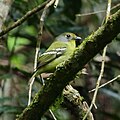Piprites
| Piprites | |
|---|---|

| |
| Black-capped piprites (Piprites pileata) | |
| Scientific classification | |
| Domain: | Eukaryota |
| Kingdom: | Animalia |
| Phylum: | Chordata |
| Class: | Aves |
| Order: | Passeriformes |
| Family: | Tyrannidae |
| Subfamily: | Pipritinae Ohlson, Irestedt, Ericson & Fjeldså, 2013[1] |
| Genus: | Piprites Cabanis, 1847 |
| Type species | |
| Pipra pileata[2] Temminck, 1822
| |
Piprites is a genus of bird currently placed in the family Tyrannidae. Prior to 1971, the genus was placed in the family Pipridae;[3] its designation was initially changed based on morphological evidence,[4] and genetic evidence confirmed its placement in 2009.[5] In 2013, it was proposed that Piprites was to be placed in the unique family Pipritinae.[1] The proposition was declined by the Comité de Clasificación de Sudamérica, a part of the American Ornithological Society, and the proposed family was changed to be a unique subfamily of the genus.[6] The genus is composed of three species native to the neotropical realm, with distributions ranging from the Caribbean coast of Guatemala, Central America, and southeastern Argentina.[7]
Etymology
[edit]The generic name Piprites is derived from the Greek πιπρα (pipra), meaning "small bird" and originally associated with the great spotted woodpecker and the various Neotropical manakins. The suffix ῑ́της (-ī́tēs) is also Greek and denotes "resembling" or "similar to", denoting the genus' similarity to the manakins.[8]
Species
[edit]The genus Piprites contains 3 species:[9]
| Image | Scientific name | Common Name | Distribution |
|---|---|---|---|
 |
Piprites chloris | Wing-barred piprites | Argentina, Bolivia, Brazil, Colombia, Ecuador, French Guiana, Guyana, Paraguay, Peru, Suriname, and Venezuela. |
 |
Piprites griseiceps | Grey-headed piprites | Costa Rica, Guatemala, Honduras, and Nicaragua. |
 |
Piprites pileata | Black-capped piprites | southeastern Brazil and northeastern Argentina |
References
[edit]- ^ a b Ohlson, J. I.; Irestedt, M.; Ericson, P.G.P.; Fjeldså, J. (2013). "Phylogeny and classification of the New World suboscines (Aves, Passeriformes)" (PDF). Zootaxa. 3613 (1): 1–35. doi:10.11646/zootaxa.3613.1.1. ISSN 1175-5326. PMID 24698900.
- ^ "Pipritidae". aviansystematics.org. The Trust for Avian Systematics. Retrieved 2023-07-24.
- ^ Hellmayr, C.E.; Conover, B.; Cory, C.B. (1929). Catalogue of birds of the Americas and the adjacent islands. Vol. 13. Field Museum of Natural History. pp. 258–266.
- ^ Ames, Peter L. (1971). "The morphology of the syrinx in passerine birds" (PDF). The Auk. 89 (4).
- ^ Tello, J. G.; Moyle, R. G.; Marchese, D.J.; Cracraft, J. (February 7, 2009). "Phylogeny and phylogenetic classification of the tyrant flycatchers, cotingas, manakins, and their allies (Aves: Tyrannides)" (PDF). Cladistics. 25 (5): 429–467. doi:10.1111/j.1096-0031.2009.00254.x. PMID 34879622. Archived from the original (PDF) on April 3, 2016.
- ^ Remsen, J.V. (May 2019). "Revise the classification and linear sequence of the Tyrannoidea: (A) Recognize a new family Onychorhynchidae; (B) Modify linear sequence of families; (C) Add three subfamilies to the Tyrannidae". Louisiana Museum of Natural History. South American Classification Committee.
- ^ Clements, J.F., Schulenberg, T.S., Iliff, M.J., Billerman, S.M., Fredericks, T.A., Sullivan, B.L. & Wood, C.L. (2019). "The eBird/Clements checklist of Birds of the World v.2019". The Cornell Lab of Ornithology.
{{cite web}}: CS1 maint: multiple names: authors list (link) - ^ Jobling, J.A. (2010). Helm Dictionary of Scientific Bird Names. Bloomsbury Publishing. p. 308. ISBN 9781408133262.
- ^ Gill, Frank; Donsker, David, eds. (2019). "Tyrant flycatchers". World Bird List Version 9.2. International Ornithologists' Union. Retrieved 27 June 2019.

